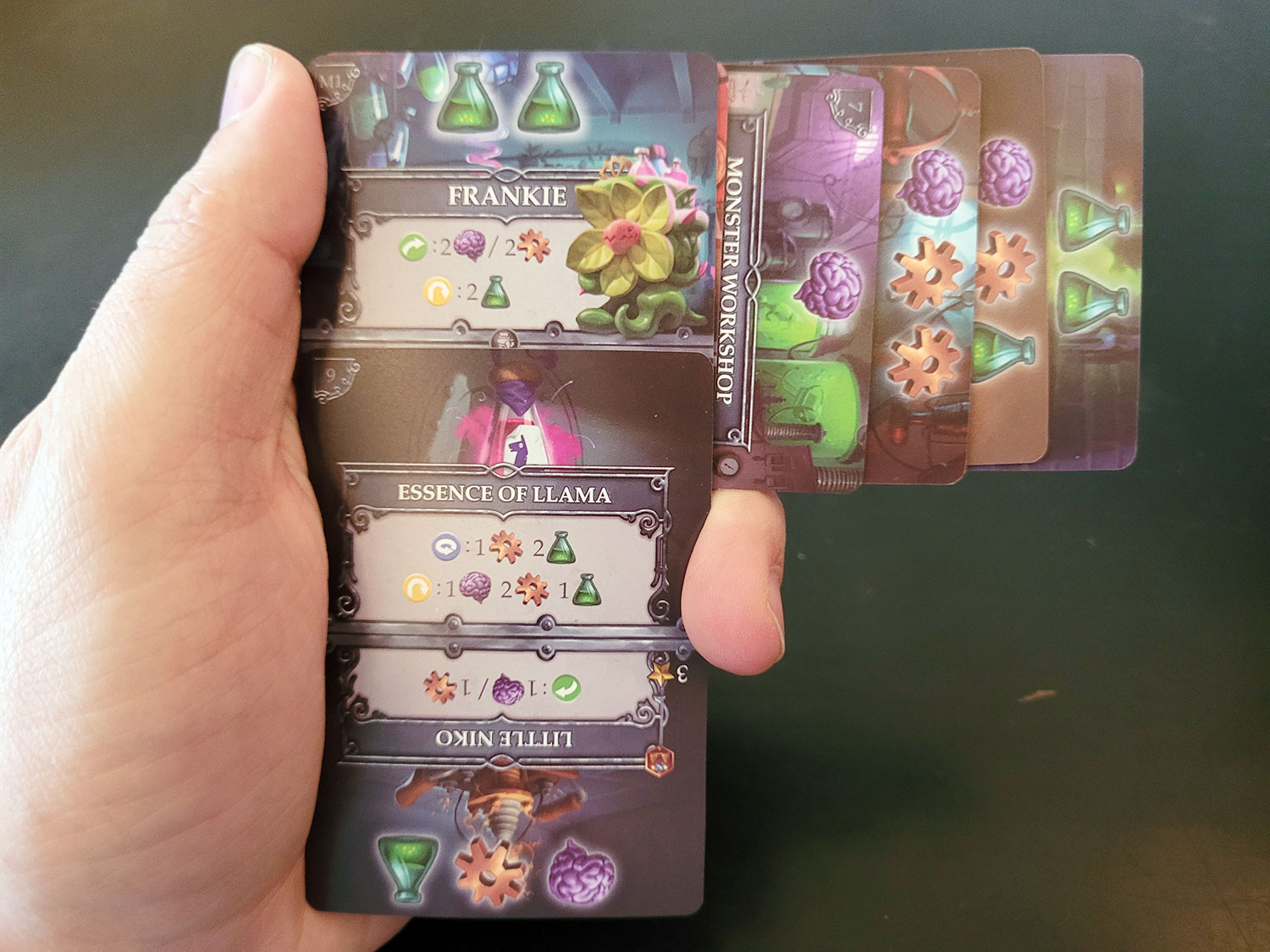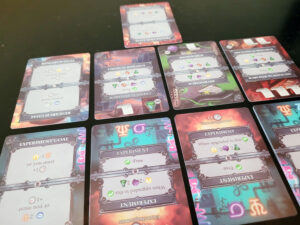 In-hand games (also called no-table-needed games) are a personal fascination of mine. As the name implies, these games are played entirely in your hand, with no playing surface necessary. It’s an odd restriction, but can lead to some very interesting designs that you would never see otherwise.
In-hand games (also called no-table-needed games) are a personal fascination of mine. As the name implies, these games are played entirely in your hand, with no playing surface necessary. It’s an odd restriction, but can lead to some very interesting designs that you would never see otherwise.
Not many in-hand games are actually published, but that doesn’t stop me from greedily devouring any new design I can get my grubby mitts on. Palm Laboratory is the latest entry in this extremely limited space, and is actually a sequel of sorts to Palm Island, which kind of invented the entire genre. Palm Laboratory trades sunny isles for dank sewers, and a beat-your-own-score framework for individual missions with distinct win/loss conditions, but the core of the game is largely unchanged.
Palm Laboratory is an engine-building game for just 1 player, and plays in 10-20 minutes.
Gameplay Overview:
Depending on the mission, Palm Laboratory uses anywhere from 18 to 25 cards. Some are seeded at the back of the deck to track end-of-round miscellany, and the rest are shuffled and placed at the front. This deck is held in your hand for the entire game.

Each turn, you may take any action on the active (upright and facing you) section of one of the top two cards, placing it at the back of the deck after you do so. Some actions let you store that card, rotating it 90 degrees so the icons at the top can be used as resources. Other actions require you to pay stored resources for them (by rotating those resources back into the deck), but allow you to reorient that card, making it more useful in the next round. For example, a card may start with the ability to store it for a single resource, but provide additional resources if you instead choose to upgrade it.
These upgrades are necessary to fulfill your mission objective. When you encounter the objective card at the end of the deck, you must either spend a certain combination of resources to advance the objective, or advance the danger meter card. If you manage to advance all four sections of the objective card, before advancing the danger meter for the fourth time, you win the game.

Game Experience:
To be honest, despite my love of in-hand games, I never enjoyed Palm Island that much. It’s certainly a clever design, but felt more like a diversion than an actual game. Palm Laboratory is 90 percent the same game, but that 10 percent makes a tremendous difference, elevating the game from a neat time-waster to something I actually want to bring with me when I travel.
For those unfamiliar with the original game, the core loop of Palm Laboratory may seem overly simplistic. You only have access to two cards, and most of the actions are too expensive for most of the game, meaning you spend a lot of turns cycling through cards without accomplishing anything. However, after a few sessions, the game reveals a surprising amount of depth, mainly centered around its resource management.

You can only store four cards at a time, and if you ever encounter a stored card, it’s immediately sent to the back of the deck, wasting its potential. You need to be aggressive about spending your resources—but, if you’re too aggressive, you may find yourself unable to upgrade later cards or advance the objective card. These decisions are always simple, but rarely obvious, which is impressive in such a compact game.
The mission structure also generates a nice sense of urgency. Each time you go through the deck without advancing your objective, you get closer to losing, so you can’t afford to be inefficient with which cards you upgrade. The introductory mission is pretty straightforward, but the other two add new cards to the deck, introducing mission-specific resources and branching paths to victory. You might need to focus on upgrading certain cards over others depending on the setup, which makes each session more dynamic and interesting.

As much as I enjoy Palm Laboratory’s improvements over its predecessor, it does stumble in a few areas. The rulebook, while mostly functional, is difficult to understand if you don’t already know how the system works. Also, the game struggles to fit within its “no-table-needed” constraints, thanks to some incredibly slippery cards. I have pretty large hands, and I still had difficulty keeping cards from slipping out of the deck on occasion, which immediately breaks the game when it happens. This was also a problem with Palm Island, and I’m disappointed the publisher wasn’t able to fix it somehow.
My biggest gripe with Palm Laboratory, though, is its theme. Palm Island was never a thematic game, but its actions and cards generally made a kind of sense, and the airiness of the theme made the game feel light and breezy by comparison. In Palm Laboratory, that cohesion is completely absent. Everything is so abstract that it strips any pretense of theme from the game, leaving behind only the barest mechanical trappings. That normally wouldn’t bother me much, but in a game this simple, the theme does a lot of heavy lifting to bring me back again and again, and Palm Laboratory’s theme is pretty weak in that regard.
Final Thoughts:
If you can get past the pasted-on theme and minor accessibility issues, Palm Laboratory is a great solo filler game, and a near-complete upgrade over its predecessor. The core gameplay is sharp and surprisingly deep, and the three missions keep the game fresh over repeated plays. It’s also so compact and easy to pull out that I can bring it with me anywhere I go, which is a rare delight.
Final Score: 4 Stars – a great solo game for whenever you have 15 minutes and a spare hand.
 Hits:
Hits:
• Simple yet rewarding decisions
• Solid replay value
• Incredibly quick and portable
• Improves over its predecessor in every way…
Misses:
• …except for the theme
• Cards are too slippery
• Difficult rulebook
Source: Board Game Quest





